We’ve all experienced the afternoon slump that hits when staring at computer screens in sterile home offices. But what if we told you there’s a simple solution that can boost your productivity and transform your workspace into a vibrant sanctuary?
Adding plants to your home office isn’t just about aesthetics – it’s about creating an environment that actively supports your well-being and work performance. Studies show that incorporating greenery into workspaces can reduce stress levels by up to 37% while increasing focus and creativity. We’re talking about natural air purifiers that work around the clock to remove toxins and pump fresh oxygen into your daily grind.
Whether you’re dealing with a cramped corner setup or a spacious dedicated room we’ll show you how to strategically place plants that thrive in office conditions. From low-maintenance succulents perfect for beginners to statement plants that make bold design impacts you’ll discover the perfect green companions for your workspace.
Choose the Right Plants for Your Home Office Environment
Selecting plants that thrive in your exact workspace conditions ensures long term success and maximum productivity benefits.
Consider Light Conditions and Window Placement
Bright indirect light works best for most office plants, making north and east facing windows ideal locations. We recommend measuring your office’s light levels throughout the day to determine which plants will flourish in your space.
Low light areas near interior walls can still support greenery with the right plant choices. Plants like ZZ plants, pothos, and snake plants adapt well to fluorescent lighting and minimal natural sunlight. Medium light spaces accommodate fiddle leaf figs, rubber plants, and monstera deliciosa perfectly.
Direct sunlight exposure through south facing windows requires careful plant selection to prevent leaf burn. Succulents, cacti, and some tropical varieties like bird of paradise thrive in these bright conditions. We suggest rotating plants weekly if they receive intense afternoon sun to ensure even growth.
Select Low-Maintenance Varieties for Busy Professionals
Succulents and cacti require watering only once or twice per month, making them perfect for professionals with packed schedules. Popular varieties include jade plants, echeveria, and barrel cacti that store water in their leaves and stems.
Snake plants tolerate neglect exceptionally well and can survive weeks without water while still purifying your office air. We find that these architectural plants add modern appeal to any workspace while requiring minimal care.
Pothos varieties grow quickly in water or soil and forgive irregular watering schedules completely. Golden pothos, marble queen, and neon pothos trail beautifully from shelves or hanging planters. ZZ plants withstand low humidity, irregular watering, and poor lighting conditions while maintaining their glossy green appearance.
Rubber plants adapt to various office conditions and only need watering when their soil feels dry to the touch.
Opt for Air-Purifying Species
NASA’s Clean Air Study identifies exact plants that remove common office toxins like formaldehyde, benzene, and xylene from indoor air. We recommend incorporating these scientifically proven varieties into your workspace for maximum health benefits.
Spider plants excel at removing formaldehyde and xylene while producing baby plantlets that you can propagate easily. These resilient plants adapt to most office lighting conditions and require watering only when soil becomes dry.
Peace lilies filter out ammonia, benzene, and formaldehyde while producing elegant white blooms that signal when they need water. We’ve found these plants particularly effective in offices with printers and copiers that release chemical vapors.
Boston ferns remove formaldehyde and add humidity to dry office environments naturally. These plants prefer indirect light and consistent moisture, making them ideal for offices with stable climate control.
Bamboo palms grow tall enough to serve as natural room dividers while filtering trichloroethylene, formaldehyde, and benzene from your workspace air.
Position Plants Strategically for Maximum Impact
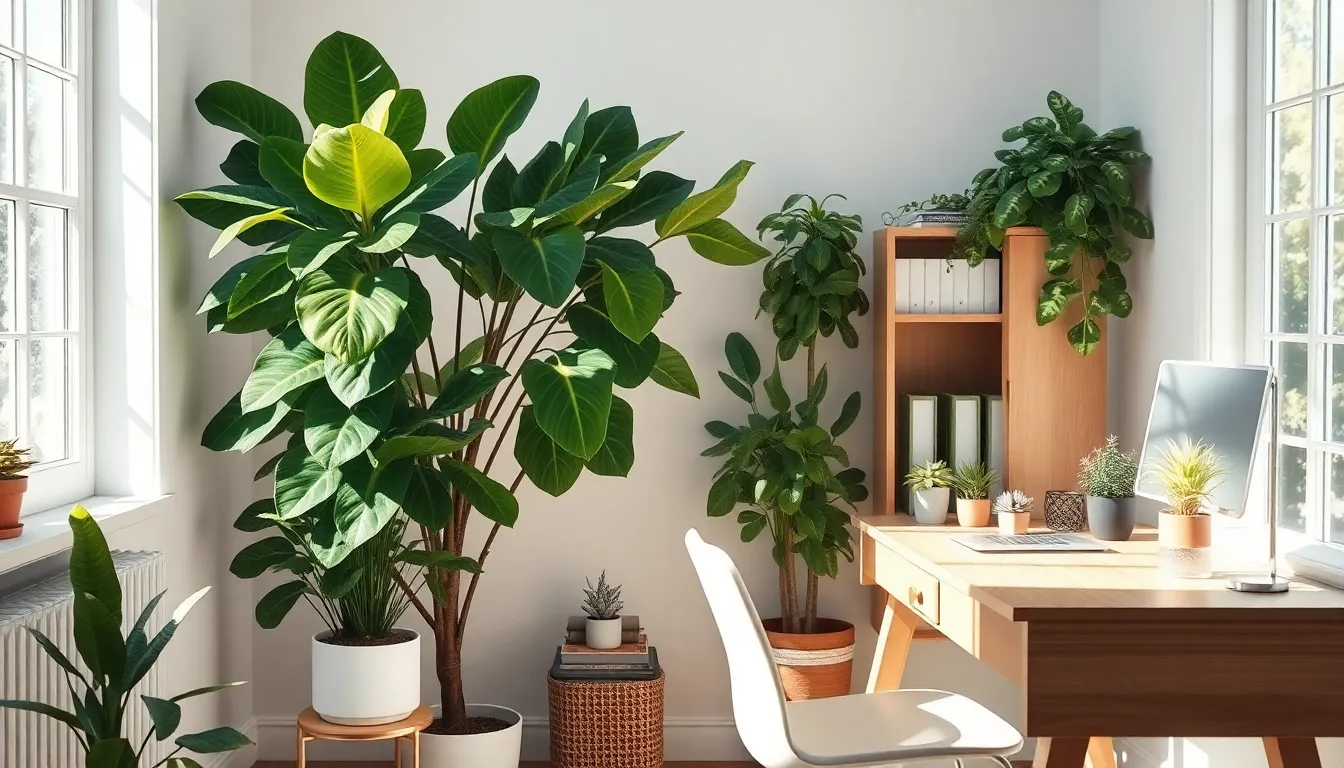
Now that we’ve selected our plants, let’s focus on placement to maximize their productivity and wellness benefits.
Place Large Plants in Empty Corners
Large plants transform neglected corners into stunning focal points that enhance both visual appeal and workspace functionality. We recommend positioning tall specimens like fiddle leaf figs or monstera deliciosa in empty corners to create natural aesthetic anchors that draw the eye and improve room balance.
These corner plants serve double duty by absorbing sound and reducing noise disturbance, which is especially valuable in open floor plans or shared home spaces. The strategic placement creates a sense of enclosure and privacy while maintaining an open feel throughout the office.
Corners naturally receive less foot traffic, making them ideal spots for larger plants that need space to spread their leaves without interference. We suggest choosing plants that can handle the typically lower light conditions found in corner areas, such as rubber trees or dracaena varieties.
Use Desk Plants to Frame Your Workspace
Small desk plants create a natural border around our immediate work area, establishing a sense of enclosure that enhances focus and concentration. Research shows that workers experience up to 15% increased productivity when plants are positioned within their direct line of sight during computer tasks.
We recommend placing 2-3 small plants strategically around your monitor and keyboard area to create this framing effect. Succulents, small pothos, or desk-sized snake plants work perfectly for this purpose without overwhelming the workspace.
These desktop companions provide quick visual breaks that help reduce mental fatigue during long work sessions. The proximity to plants creates an immediate connection with nature that lowers stress levels and blood pressure, as demonstrated in studies comparing indoor gardening tasks to computer work.
Position plants slightly off-center rather than directly in front of your screen to avoid distractions while maintaining their stress-reducing benefits within your peripheral vision.
Create Visual Balance with Varying Heights
Varying plant heights adds dimension and prevents our office from looking flat or monotonous. We achieve this by combining floor plants, desk plants, and hanging specimens to create layers that guide the eye naturally throughout the space.
This height variation promotes visual movement that refreshes mental engagement and prevents the workspace from feeling static. Tall plants in corners, medium plants on stands or shelves, and small plants on desks create a ever-changing environment that feels alive and energizing.
The strategic height placement also maximizes the functional benefits of each plant type. Floor plants provide sound absorption and air purification for the entire room while desk plants offer immediate stress relief and focus enhancement.
We recommend using the rule of threes when arranging plants of different heights, grouping them in odd numbers to create the most visually pleasing and balanced composition. This approach transforms sterile office spaces into thriving ecosystems that support both productivity and well-being.
Incorporate Plants That Boost Productivity and Focus
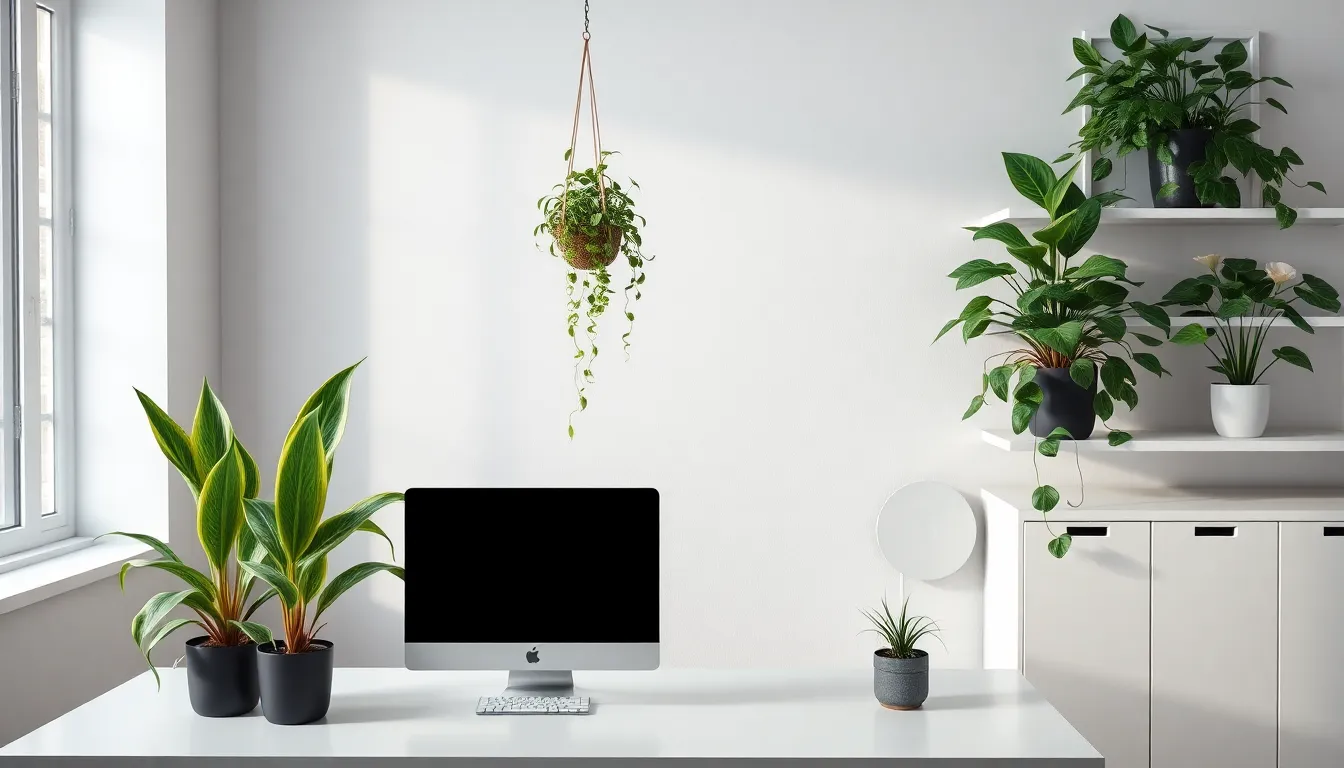
Research shows that office plants can boost productivity by up to 47% and improve memory by 20%, making strategic plant selection essential for optimizing our workspace performance.
Add Snake Plants for Improved Air Quality
Snake plants excel at filtering indoor pollutants and increasing oxygen levels in our home offices. Their exceptional air purifying qualities directly support better cognitive function throughout the workday. We’ll notice improved mental clarity as these hardy plants work continuously to remove toxins from our breathing space.
Place snake plants near our desk or computer area where we spend most of our working hours. These low maintenance plants thrive in various lighting conditions and require minimal watering. Their upright growth pattern makes them perfect for corners or spaces where floor area is limited.
Include Pothos for Stress Reduction
Pothos plants create a naturally calming atmosphere that helps maintain mental clarity during demanding work sessions. Studies indicate these trailing plants effectively reduce anxiety levels in office environments. We can position pothos on shelves or in hanging planters to maximize their stress reducing benefits.
Their hardy nature means we won’t need to worry about complex care routines while working. Pothos adapts well to different light conditions and forgives occasional watering mistakes. These plants work best when placed within our line of sight but not directly blocking our computer screen.
Position Peace Lilies for Enhanced Concentration
Peace lilies boost concentration by removing airborne toxins and adding beneficial humidity to our workspace. Research demonstrates that improved air quality from these plants prevents dry air related discomfort that can break our focus. We’ll experience sustained attention spans when peace lilies filter our office environment.
Position these flowering plants away from direct sunlight but within view of our primary work area. Their visual appeal contributes to a soothing workspace atmosphere while their air purifying properties work continuously. Peace lilies signal when they need water by drooping slightly, making maintenance straightforward for busy professionals.
Design Plant Displays That Complement Your Office Decor
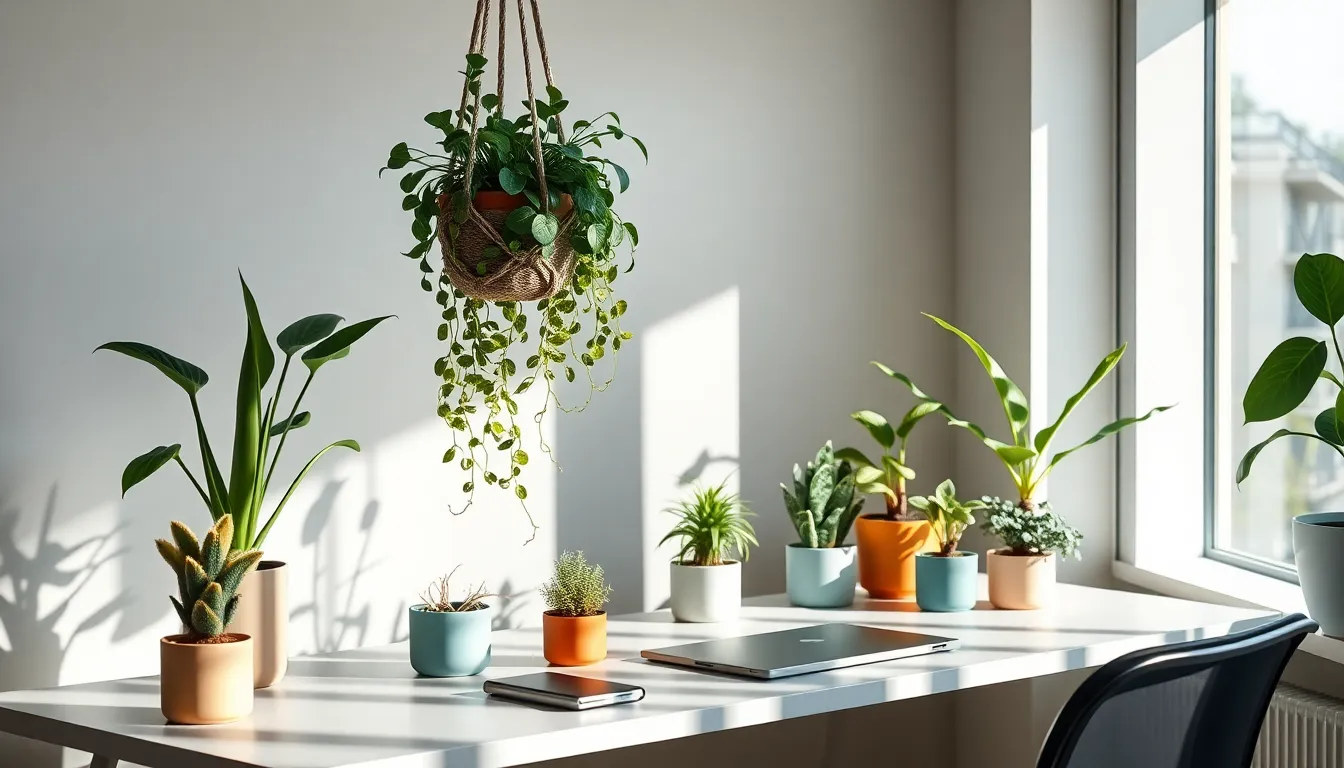
Creating cohesive plant displays elevates your home office from functional to inspiring. We’ll show you how to arrange greenery that enhances rather than competes with your existing workspace design.
Match Planters to Your Color Scheme
Selecting containers that complement your office palette creates visual harmony throughout your workspace. We recommend choosing pots in neutral tones like white, black, or natural wood if your office features bold colors or patterns. These understated planters allow your plants to shine while maintaining design cohesion.
For minimalist offices with neutral walls and furniture, colorful ceramic pots or metallic finishes add personality without overwhelming the space. Terra cotta planters work beautifully in warm-toned offices with wooden desks and earth-colored accessories. Modern workspaces benefit from sleek geometric planters in matte black or concrete gray that echo contemporary design elements.
Consider the finish of your office hardware when selecting planters. Brass or copper containers complement gold-toned desk accessories and light fixtures. Chrome or stainless steel planters align perfectly with modern office equipment and silver-finished furniture.
Use Hanging Plants to Save Desk Space
Suspended greenery maximizes your plant collection without sacrificing valuable work surface area. We suggest installing ceiling hooks or wall-mounted brackets to display trailing varieties like pothos, string of hearts, or spider plants above your desk.
Macrame hangers add texture and bohemian charm to eclectic office spaces. Metal hanging planters suit industrial or modern aesthetics while maintaining clean lines. Place hanging plants at varying heights to create visual interest and prevent your display from looking too uniform.
Corner spaces often go unused in home offices, making them perfect spots for hanging plant installations. Suspend multiple plants at different levels to create a living curtain that softens harsh architectural lines. This approach works especially well in offices with high ceilings where floor space remains uncompromised.
Create Themed Plant Arrangements
Grouping plants by similar characteristics creates intentional displays that feel curated rather than random. We recommend starting with a succulent collection for low-maintenance themed arrangements that work well on floating shelves or desk corners. Varieties like echeveria, jade plants, and aloe vera share similar care requirements while offering diverse textures and colors.
Tropical themes bring lush jungle vibes to your workspace through combinations of monstera, fiddle leaf figs, and bird of paradise plants. These arrangements work best in offices with ample natural light and higher humidity levels. Position larger specimens as anchor points and fill in with smaller tropical varieties.
Herb gardens serve dual purposes in home offices by providing fresh ingredients for meals while adding pleasant fragrances to your workspace. Arrange basil, rosemary, and mint plants on sunny windowsills or under grow lights. This themed approach connects your office to your kitchen and adds practical value to your plant collection.
Monochromatic arrangements using plants with similar foliage colors create sophisticated displays that complement professional environments. Green-only arrangements featuring various shades and textures of foliage maintain visual interest without introducing competing colors to your carefully planned office palette.
Maintain Your Home Office Plants for Long-Term Success
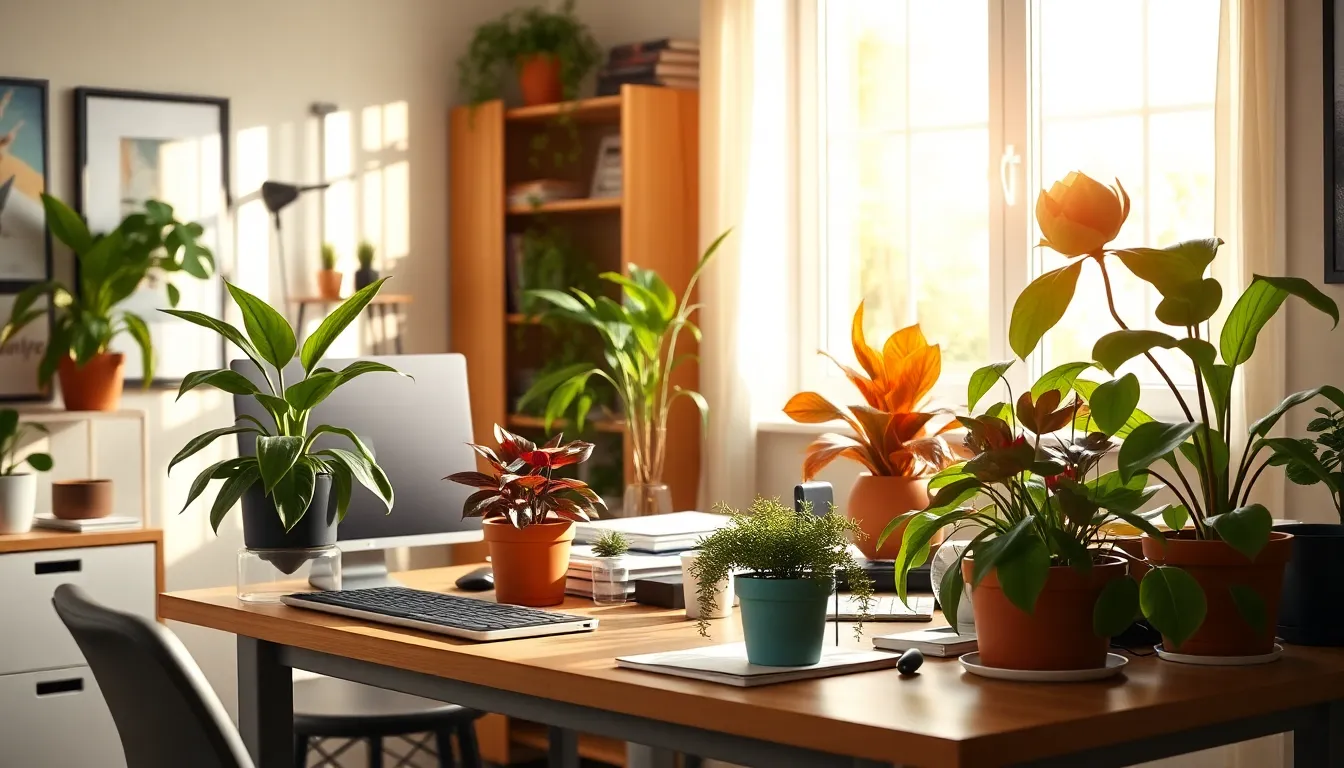
Once you’ve strategically placed your plants for maximum impact, establishing proper care routines ensures they’ll continue improving your workspace for years to come. We’ll show you how simple maintenance practices can keep your office plants thriving.
Establish a Regular Watering Schedule
Watering becomes effortless when we check soil moisture before adding water. Feel the top inch of soil with your finger and only water when it’s completely dry to the touch. Use lukewarm water and pour slowly until it drains through the bottom holes of the pot.
Standing water kills more office plants than drought does. Empty any excess water from saucers within 30 minutes to prevent root rot. We recommend tying watering to a exact day each week, like “Watering Wednesday,” to maintain consistency across all your plants.
Different plants drink at different rates throughout the year. Snake plants might need water every 2-3 weeks while pothos plants typically require weekly attention. Monitor each plant individually rather than watering everything on the same schedule.
Monitor Light Requirements Throughout Seasons
Light conditions change dramatically as seasons shift in our home offices. Move plants closer to windows during darker winter months and pull them back during intense summer sun. Your peace lily that thrived three feet from the window in June might need to sit directly on the windowsill come December.
Dust accumulation blocks light absorption and attracts pests. Wipe leaves weekly with a damp cloth to ensure maximum light penetration. Clean leaves also improve the overall appearance of your workspace display.
Rotating plants every few weeks prevents them from leaning toward light sources. This simple practice promotes even growth and maintains the balanced look you’ve carefully designed. Watch for signs like stretching stems or pale leaves that indicate insufficient light exposure.
Prune and Repot When Necessary
Pruning dead or yellowing leaves redirects energy toward healthy new growth. Remove damaged foliage as soon as you notice it using clean scissors or pruning shears. This prevents pest problems and keeps your plants looking professional in your workspace.
Monthly spa days keep plants in peak condition year round. Flush soil thoroughly with water to remove salt buildup, trim any damaged parts, and inspect for pest issues. These sessions take just 10-15 minutes per plant but dramatically improve their health.
Repotting becomes necessary when roots circle the pot’s bottom or soil stays soggy after watering. Most office plants need fresh soil and larger containers every 12-18 months. Spring offers the best timing for repotting since plants enter their active growing season.
Root bound plants show stunted growth and require water more frequently. Check root systems annually by gently removing plants from their pots. Healthy white roots indicate good plant health while black or mushy roots signal problems requiring immediate attention.
Maximize Small Spaces with Vertical Plant Solutions
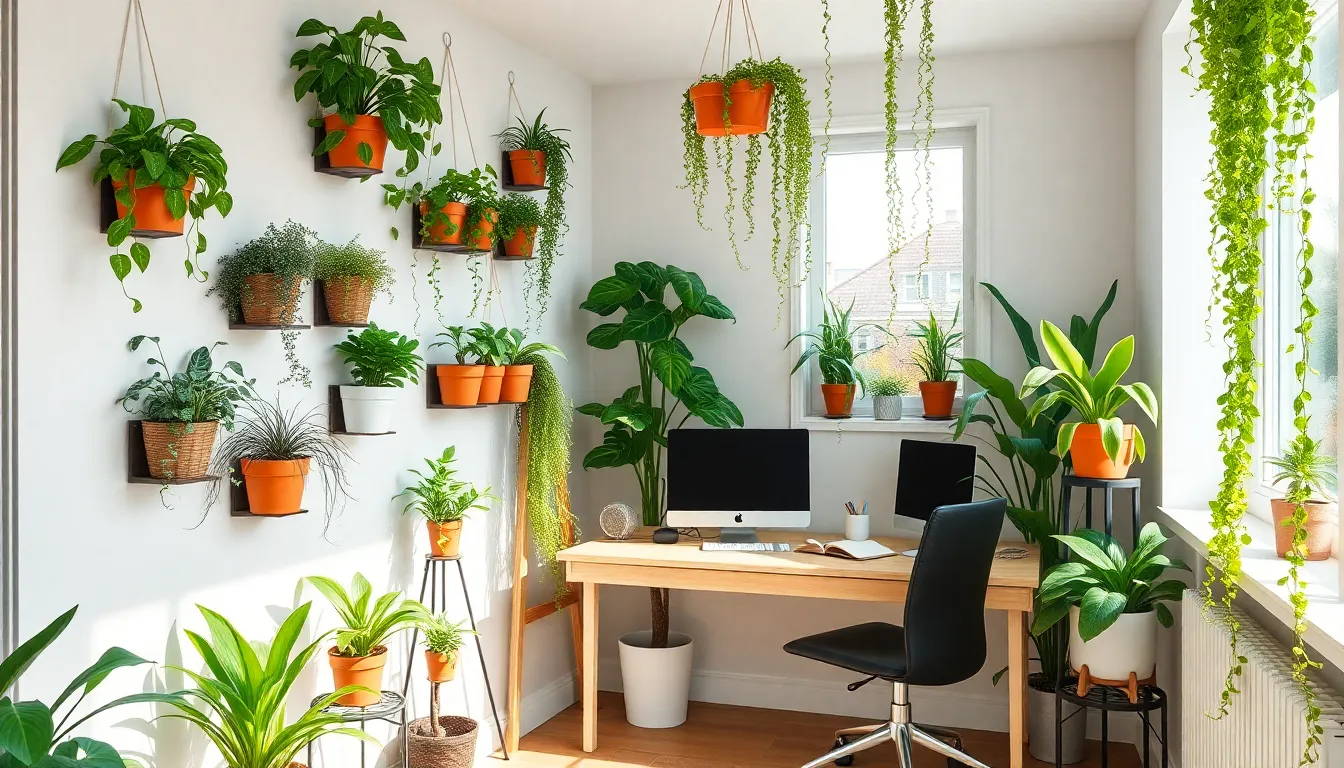
We can transform even the smallest home offices into green havens by utilizing vertical growing techniques that add life without consuming precious floor space.
Install Wall-Mounted Planters
Wall-mounted planters offer the perfect solution for introducing greenery while keeping our desks clear and functional. These space-saving systems attach directly to walls, allowing us to display multiple plants in a vertical arrangement that draws the eye upward. We’ll improve our indoor air quality while creating a soothing atmosphere that enhances productivity throughout the workday.
Modular living wall systems provide even greater flexibility, supporting various plant types while often including built-in irrigation features for effortless maintenance. These systems make plant care simpler for busy professionals who want the benefits of office greenery without the daily hassle. We can choose from sleek metal designs for modern offices or natural wood finishes that complement traditional decor styles.
Use Plant Stands and Shelving Units
Plant stands and shelving units maximize our vertical space by fitting into corners and narrow gaps that might otherwise go unused. Tiered stands create beautiful layers of greenery while maintaining our office’s compact footprint. We can mix plants of different sizes and heights to add visual interest without overwhelming the space.
Shelving offers incredible versatility, allowing us to integrate office supplies and decorative items alongside our plant collection. This approach creates a balanced look that feels intentional rather than cluttered. We’ll find that corner shelving units work particularly well in small offices, transforming dead space into productive growing areas.
Incorporate Trailing Plants from Above
Hanging trailing plants bring natural elements into our eye-level workspace without taking up any desk or floor area. Plants like pothos, philodendrons, and string of pearls create ever-changing flowing visuals that enhance our office ambiance naturally. We can install hanging pots and baskets easily from ceiling hooks or upper shelf edges.
These cascading plants help delineate different zones within our small office while adding movement and texture to the space. The trailing effect softens harsh office angles and creates a more welcoming environment for video calls and daily work tasks. We’ll discover that hanging plants also improve our indoor air quality by regulating humidity and producing fresh oxygen throughout the day.
Create a Productive Atmosphere with Plant Psychology
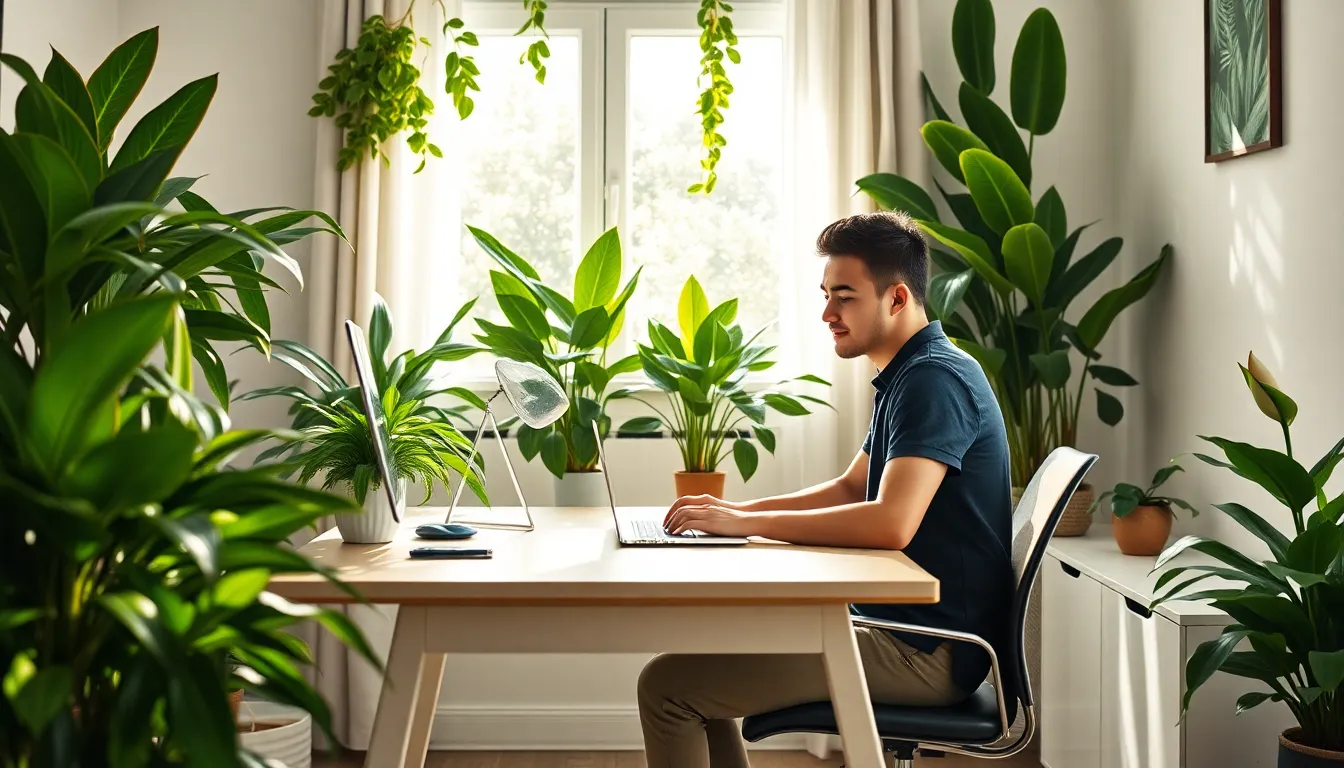
We can harness the psychological benefits of plants to transform our home office into a productivity powerhouse. Plants engage our biophilia connection to nature, directly impacting worker satisfaction and concentration levels.
Use Green Colors to Reduce Eye Strain
Green hues from our office plants naturally soothe tired eyes after hours of screen time. The calming color acts as a visual break that refreshes both our eyes and mind throughout the workday. Exposure to green tones reduces digital eye fatigue while promoting better focus and mental clarity. This natural color palette serves as a subtle cognitive stimulus that supports sustained attention during demanding tasks.
Position Plants to Define Work Zones
Strategic plant placement creates invisible boundaries that help us mentally shift between different work activities. Large floor plants positioned around our desk establish a clear workspace perimeter while smaller plants between areas signal task transitions. Greenery acts as natural room dividers that bring order and purpose to our home office layout. These living boundaries enhance our workspace aesthetics while providing psychological support for maintaining focus and productivity.
Leverage Natural Elements for Mental Clarity
Plants actively improve our indoor air quality by increasing oxygen levels essential for optimal brain function. Research from Exeter University demonstrates that indoor plants boost concentration and productivity by up to 47% while improving memory performance by 20%. Air purifying plants like spider plants and peace lilies remove toxins that can cloud our thinking and reduce cognitive performance. Natural aromatherapy from plants energizes our mind and contributes to sustained mental clarity throughout our workday. Studies led by Marlon Nieuwenhuis confirm that adding plants to office spaces increases productivity by 15% through improved concentration and workplace satisfaction.
Conclusion
Creating a thriving home office with plants isn’t just about aesthetics—it’s an investment in our productivity and well-being. We’ve explored how the right combination of greenery can transform our workspace into a more focused and energizing environment.
The key lies in making thoughtful choices that align with our exact office conditions and lifestyle. Whether we’re working with limited space or abundant natural light our plant selection and placement strategies can make all the difference.
With proper maintenance and strategic design our plant-enhanced home office becomes a sustainable sanctuary that supports our professional goals while nurturing our connection to nature. The science-backed benefits speak for themselves—it’s time to let our workspace bloom.
Frequently Asked Questions
How do plants improve productivity in home offices?
Plants can enhance productivity by up to 47% and improve memory by 20%. They reduce stress levels, boost focus and creativity, and provide visual breaks during long screen time. The green hues help reduce eye strain and promote mental clarity, while plants also absorb sound and create a calming atmosphere that supports better work performance.
What are the best low-maintenance plants for busy professionals?
Succulents, snake plants, ZZ plants, and pothos are ideal for busy professionals. These plants require minimal care and can thrive in various lighting conditions. Snake plants and ZZ plants tolerate low light and infrequent watering, while succulents need minimal attention and pothos are very forgiving if you forget to water occasionally.
Which plants are best for purifying office air?
NASA’s Clean Air Study identifies spider plants, peace lilies, bamboo palms, snake plants, and pothos as excellent air purifiers. These plants remove common indoor toxins and increase oxygen levels, which supports cognitive function. Peace lilies also add humidity to the workspace, while snake plants filter pollutants that can affect concentration.
How should I place plants in my home office for maximum impact?
Place large plants like fiddle leaf figs in empty corners for visual appeal and sound absorption. Position small desk plants within your line of sight to enhance focus. Create visual balance by varying plant heights with floor plants, desk plants, and hanging specimens. This strategic placement maximizes both aesthetic and functional benefits.
What lighting conditions do most office plants need?
Most office plants thrive in bright indirect light, which means near a window but not in direct sunlight. For low-light areas away from windows, choose ZZ plants, pothos, or snake plants. Monitor light requirements as seasons change, and consider moving plants closer to or further from windows based on their specific needs.
How can I incorporate plants in a small office space?
Use vertical solutions like wall-mounted planters, modular living wall systems, and plant stands to maximize space. Hanging trailing plants add greenery without occupying desk space. Shelving units allow you to mix plants with office supplies. These vertical arrangements save valuable surface area while still providing air quality and aesthetic benefits.
How do I maintain office plants for long-term success?
Establish a regular watering schedule based on each plant’s needs. Monitor and adjust lighting as seasons change. Clean leaves regularly to prevent dust accumulation, which can block light absorption. Prune dead or yellowing leaves and repot when plants outgrow their containers. Consistent care prevents pest issues and promotes healthy growth.
Can plants help define work zones in my home office?
Yes, plants create natural boundaries that help define work areas and maintain focus. Large floor plants can separate different zones, while desk plants frame your immediate workspace. This strategic placement helps create psychological boundaries between work and relaxation areas, especially important in home office environments where spaces often overlap.







